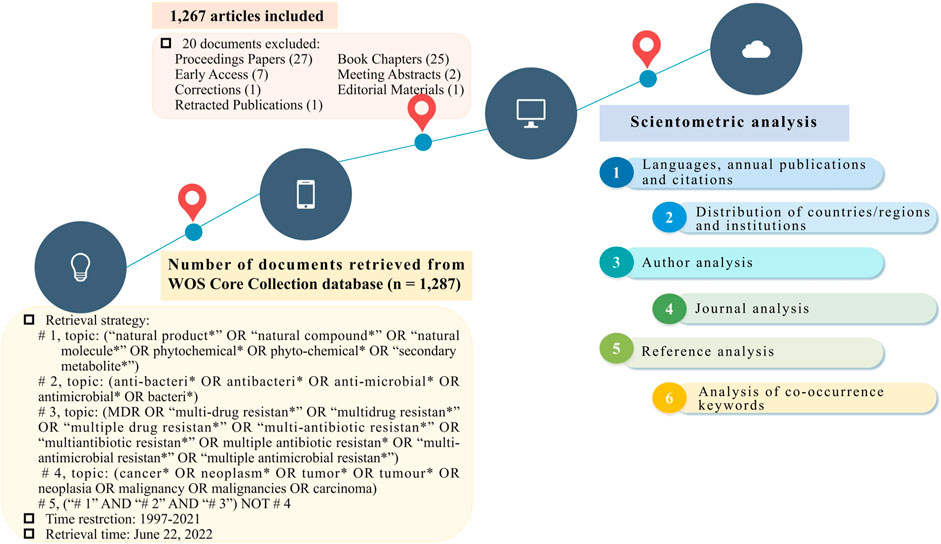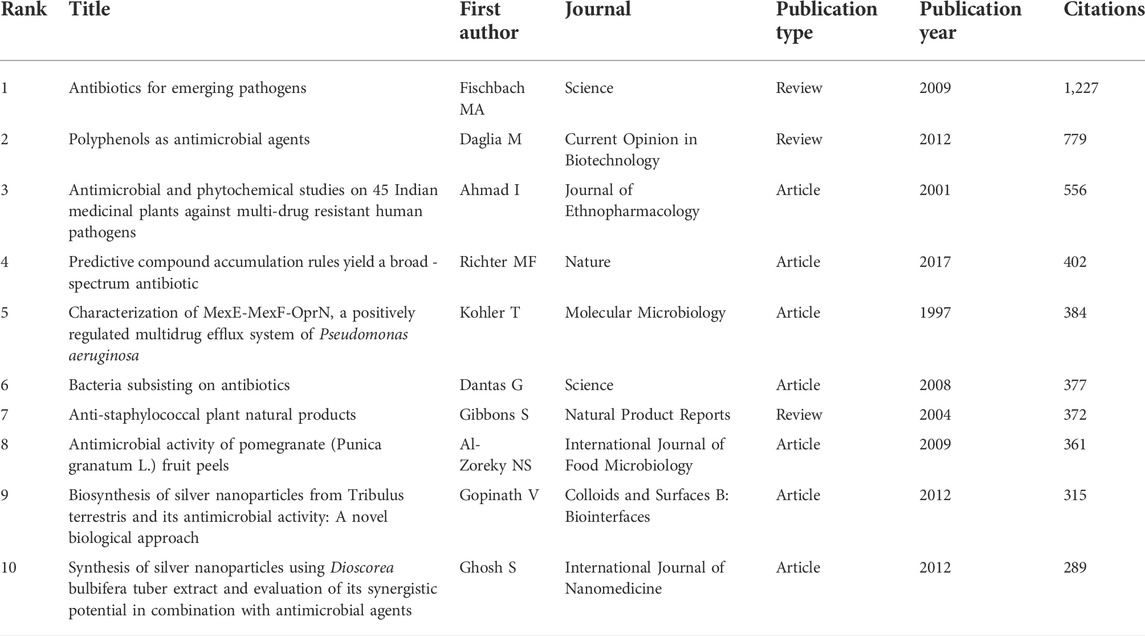- 1State Key Laboratory of Characteristic Chinese Medicine Resources in Southwest China, College of Pharmacy, Chengdu University of Traditional Chinese Medicine, Chengdu, China
- 2Library, Chengdu University of Traditional Chinese Medicine, Chengdu, China
Objective: A growing number of studies have demonstrated the antimicrobial activity of natural products against multidrug-resistant bacteria. This study aimed to apply scientometric method to explore the current status and future trends in this field.
Methods: All relevant original articles and reviews for the period 1997–2021 were retrieved from the Web of Science Core Collection database. VOSviewer, a scientometric software, and an online bibliometric analysis platform were used to conduct visualization study.
Results: A total of 1,267 papers were included, including 1,005 original articles and 262 reviews. The United States and India made the largest contribution in this field. The University of Dschang from Cameroon produced the most publications. Coutinho HDM, Kuete V, and Gibbons S were key researchers, as they published a great many articles and were co-cited in numerous publications. Frontiers in Microbiology and Antimicrobial Agents and Chemotherapy were the most influential journals with the highest number of publications and co-citations, respectively. “Medicinal plants”, “methicillin-resistant Staphylococcus aureus”, “biofilm”, “minimum inhibitory concentration”, and “efflux pumps” were the most frequently used keywords, so these terms are presumed to be the current hot topics. All the included keywords could be roughly divided into four major themes, of which the theme of “natural product development approach” had attracted much attention in recent years. Furthermore, “Pseudomonas aeruginosa”, “nanoparticles”, “green synthesis”, “antimicrobial peptides”, “antibiofilm”, “biosynthetic gene clusters”, and “molecular dynamics simulation” had the latest average appearance year, indicating that these topics may become the research hot spots in the coming years.
Conclusion: This study performed a scientometric analysis of the antibacterial activity of natural products against multidrug-resistant bacteria from a holistic perspective. It is hoped to provide novel and useful data for scientific research, and help researchers to explore this field more intuitively and effectively.
Introduction
Infections induced by bacterial pathogens are one of the major causes of morbidity and mortality worldwide (Moore, et al., 2017). Antibiotic treatment is undoubtedly one of the indispensable strategies of modern medicine in order to combat infections or microbes, such as in cancer therapy, organ transplantation, management of preterm babies, or major surgeries (Laxminarayan, et al., 2013). The “golden era” of antibiotic discovery was from the 1930s to the 1960s (Nathan and Cars, 2014). Meanwhile, in the middle of the 20th century, antibiotics were considered as the “wonder drug”. At the time, there was optimism that communicable disorders were nearly conquered (Zaman, et al., 2017). Unfortunately, when microbes are exposed to antibiotics, the likelihood of drug resistance elevates (Rogers Van Katwyk et al., 2020). The underuse, overuse and misuse of antibiotics lead to the development of resistant pathogens (Davies and Davies, 2010). Furthermore, antibiotic resistance is a growing threat to human, animal, and environment health due to the emergence, spread, and persistence of multidrug-resistant (MDR) bacteria or “super bugs” (Aslam, et al., 2018). In general, MDR bacteria are resistant to three or more antibiotics; while Mycobacterium tuberculosis strains are extremely resistant to almost all classes of antimicrobials (Subramani, et al., 2017). Ultimately, the discovery of antibiotics has not kept pace with the emergence and development of drug resistant pathogens (Aslam, et al., 2018). A number of important organizations, such as the World Health Organization (WHO), US Centers for Disease Control and Prevention, European Medicines Agency, and World Economic Forum have recognized antibiotic resistance as a global concern (Michael, et al., 2014; Rogers Van Katwyk et al., 2020; Spellberg et al., 2016). It currently threatens tens of millions of lives and poses a major challenge to the global economy and development (Hashem et al., 2022; Rogers Van Katwyk et al., 2020). Consequently, more research and novel sources of antibiotics are urgently needed to overcome resistant problems.
Historically, natural products have played a crucial role in the identification and development of antimicrobial agents (Moloney, 2016). For instance, microbial-derived compounds account for the majority of antibiotic drugs. Decades of purification of antibiotics from microbial sources have identified an estimated 28,000 compounds, about 200 of which have been used directly as drugs. In addition, semi-synthetic improvements to these scaffolds yielded an additional 200–300 drugs, vastly exceeding the number of synthetic antibiotics in clinical use (Wright, 2017). Besides, the phytochemicals of plants are numerous in structure, have few side effects, and most of them have antibacterial activity. As a result, they acquired extra attention in the pharmaceutical industry to enhance the biological activity of existing antibiotics or as a potential source of novel antimicrobial agents active against a variety of pathogens, including MDR bacteria (Jubair, et al., 2021; Salem, et al., 2022). Moreover, β-lactams, tetracycline, macrolides, glycopeptides, lincosamides, sulfonamides, oxazolidinones, and fluoroquinolones are representative classes of antibiotics of the modern era, of which six represent naturally occurring compounds, and only the latter three are obtained entirely by chemical synthesis (Rossiter, et al., 2017). In general, natural-product antibiotics hold a privileged position in this field for the following main reasons: First, they are the products of millions of years of evolution. Through natural selection, they interact with cellular targets with high selectivity and efficiency and avoid drug resistance. Next, unlike numerous synthetic molecules, they are products of evolution that have inherent physicochemical properties necessary to penetrate bacterial cells. Finally, molecular selectivity is a hallmark of a large number of naturally occurring antibiotics, resulting in relatively little widespread toxicity (Wright, 2017).
Scientometrics is the quantitative analysis of bibliographic information using mathematical and statistical approaches. It is usually used to identify overall knowledge frameworks, assess current conditions, and predict future research directions in a certain field (Bornmann and Leydesdorff, 2014; de Castilhos Ghisi et al., 2020). In addition, it can be used to compare the contributions of different countries, institutions, journals, and authors (Ke, et al., 2020). Currently, various visualization tools, such as VOSviewer, CiteSpace, and HistCite have been developed to create knowledge maps and are widely used in multiple scientific research fields, including the medical field (Chen, et al., 2021; Huang, et al., 2021). Given the emergence of MDR bacteria and the importance of natural products in antibiotic drug discovery, numerous studies have been performed in recent years (Hashem and Salem, 2022; Moore, et al., 2017; O’Connell, et al., 2013; Rossiter, et al., 2017). However, as far as we know, no scientometric studies have been reported so far. In view of this, we conducted a scientometric analysis of the antimicrobial activity of natural products against MDR bacteria over a 25-year period from 1997 to 2021. The objective of this study was to identify the major contributors and their collaborative networks, including countries, institutions, and authors, as well as influential journals and references. Additionally, major research clusters, hot topics, and emerging trends in this field are explored.
Materials and methods
Data source and search strategy
Scientometric data were extracted from the Core Collection database of Web of Science (WOS) on 22 June 2022. The retrieval terms and search strategies were used as follows: # 1, topic: (“natural product*” OR “natural compound*” OR “natural molecule*” OR phytochemical* OR phyto-chemical* OR “secondary metabolite*”); # 2, topic: (anti-bacteri* OR antibacteri* OR anti-microbial* OR antimicrobial* OR bacteri*); # 3, topic: (MDR OR “multi-drug resistan*” OR “multidrug resistan*” OR “multiple drug resistan*” OR “multi-antibiotic resistan*” OR “multiantibiotic resistan*” OR “multiple antibiotic resistan*” OR “multi-antimicrobial resistan*” OR “multiple antimicrobial resistan*”); # 4, topic: (cancer* OR neoplasm* OR tumor* OR tumour* OR neoplasia OR malignancy OR malignancies OR carcinoma); # 5, (“# 1” AND “# 2” AND “# 3”) NOT # 4. WOS ignores the hyphen in the search query, for instance, “multiple drug resistan*” would return records that contain the string “multiple-drug resistan*”, “multiple drug-resistan*”, or “multiple-drug-resistan*”. The asterisk (*) is used as a wildcard in the retrieval strategy to represent any group of characters or no character, for example, “multi-drug resistan*” would return “multi-drug resistant” or “multi-drug resistance” (Willem, et al., 2017). Additionally, the time span of the retrieve was from 1997 to 2021, and the publication type was filtered to original articles or reviews. The steps of literature retrieval and selection are presented in Figure 1.
Data extraction and analysis
According to the search strategy developed above, a total of 1,267 publications were retrieved. By using the export function of WOS, the titles, authors, journals, abstracts and other records of these documents were exported as tab delimited files to VOSviewer software for subsequent analysis. The impact factor (IF) and category partition (Q1, Q2, Q3, and Q4) of each journal were collected from the Journal Citation Reports (JCR) 2021. Data process and cleaning was conducted manually in Microsoft Office Excel 2013. Microsoft Office PowerPoint 2013 was used to create figures on annual research output. Research collaborations between countries are conducted using an online bibliometric analysis platform (https://bibliometric.com/). The rest of the scientometric visualization was performed using VOSviewer 1.6.17. In the network and overlay graph, each node indicates a different parameter, such as countries/regions, journals, authors, and keywords. The different colors of the nodes represent different categories or publication times. The size of the node depends on the number of publications, citations, or occurrences. The link lines between nodes represent the correlation between parameters, the thickness of the lines indicates the strength of the link, and the strength of the link is quantitatively evaluated by total link strength (TLS). In the VOSviewer density graph, the color of the nodes represents the density of the parameter. The darker the color, the more frequently the parameter appears (Huang, et al., 2021; Wu, et al., 2021a; Wu, et al., 2021b).
Results
Languages, annual publications and citations
The literature search resulted in 1,267 related publications including 1,005 original articles and 262 reviews in a period from 1997 to 2021. A total of 5 languages were used in the collected articles, including English (n = 1,258, 99.29%), Portuguese (n = 6, 0.47%), Chinese (n = 1, 0.08%), Japanese (n = 1, 0.08%), and Spanish (n = 1, 0.08%). The trend of annual publications and citations over the past 25 years is displayed in Figure 2. The number of articles increased from 1 in 1997 to 237 in 2021, and about 65.4% of them were published in the last 5 years. Similar to the annual number of publications, the number of annual citations had an upward trend. The total number of citations for all publications was 34,719 (33,242 times without self-citations), with an average of 27.4 per article, and the H-index of all documents was 87.
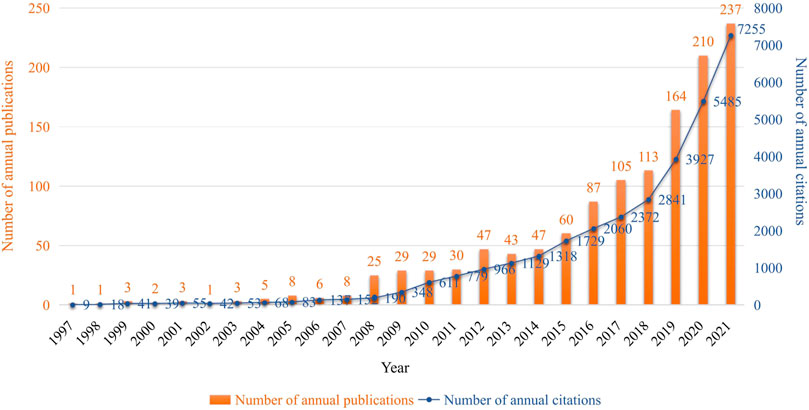
FIGURE 2. Distribution of annual publications and citations related to resistance of natural products to MDR bacteria from 1997 to 2021.
Distribution of countries/regions and institutions
A total of 95 countries/regions contributed to publications related to resistance of natural products to MDR bacteria. India was the country with the largest output, with 256 papers (20.21%), followed by the United States (212, 16.73%), China (127, 10.02%), Brazil (90, 7.10%), and England (68, 5.37%) (Figure 3A). Articles from the United States had the most citations (8,957 times), followed by India (5,455 times), England (3,396 times), China (2,391 times), and Italy (1,900 times) (Figure 3B). Figure 3C illustrates international cooperation among all countries/regions. The United States demonstrated the most active cooperation, and had close collaborations with India, China, Germany and Canada. Figure 3D displays the country co-authorship network visualization map using VOSviewer. Only countries/regions with 5 or more papers were included, and 52 countries/regions met this threshold. The top five countries with the highest TLS were the United States (TLS = 151), China (TLS = 93), India (TLS = 80), Saudi Arabia (TLS = 77), and Germany (TLS = 74).
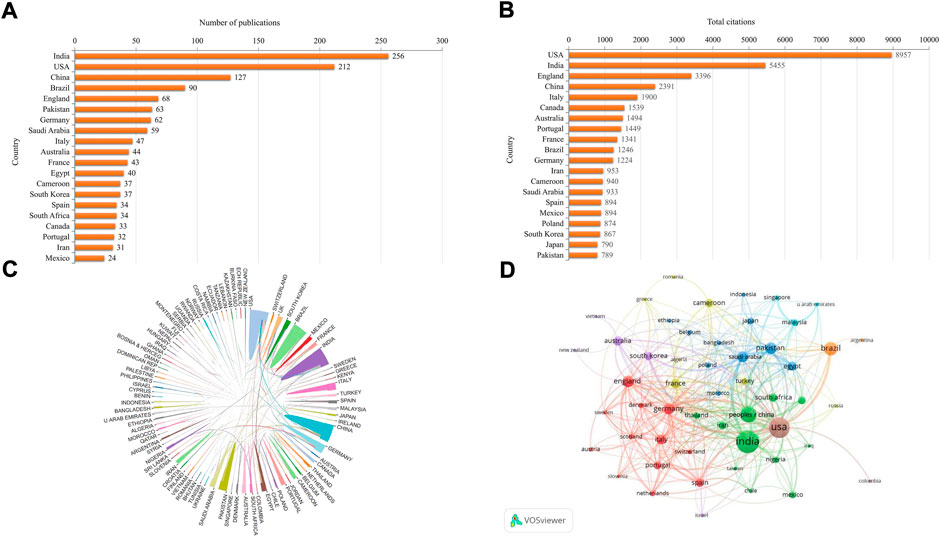
FIGURE 3. Geographical distribution and international cooperation of countries/regions related to resistance of natural products to MDR bacteria. (A) Top 20 countries/regions with the largest number of publications. (B) Top 20 countries/regions with the largest number of citations. (C) International cooperation among all countries/regions. (D) Network visualization map of co-authorship among countries/regions with 5 or more publications.
In terms of institution analysis, a total of 1,881 institutions contributed to the publications in this filed. The top 10 most prolific institutions are presented in Table 1. The University of Dschang from Cameroon was the leading contributor in terms of number of articles with 33 papers (2.60%), followed by Regional University of Cariri (27, 2.13%), King Saud University (22, 1.74%), Federal University of Paraiba (21, 1.66%), and University of Porto (20, 1.58%). The University of London had the highest citation/publication ratio (83.81) among the top 10 productive institutions. Figure 4 shows the institution co-authorship network visualization map using VOSviewer. Only institutions with 5 or more publications were included, and 83 institutions met this threshold. The five institutions with the highest TLS were Regional University of Cariri (TLS = 33), Federal University of Paraiba (TLS = 28), Universidade Federal do Piaui (TLS = 20), University of Dschang (TLS = 17), and University of Porto (TLS = 16).

TABLE 1. The top 10 productive institutions related to resistance of natural products to MDR bacteria.
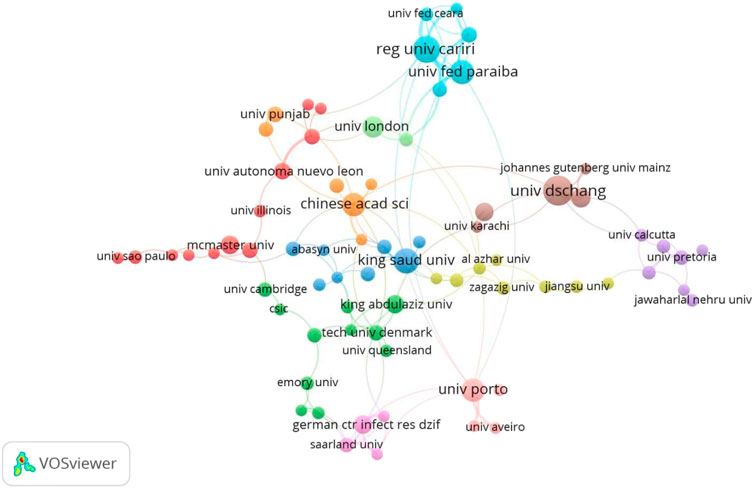
FIGURE 4. Network visualization map of co-authorship among institutions with 5 or more publications.
Author analysis
A total of 6,438 authors were involved in the antimicrobial effect of natural products against MDR bacteria. The top 10 authors according to the number of papers contributed 131 papers (10.34%) in this field (Table 2). Coutinho HDM from Brazil published the most articles (33, 2.60%), followed by Kuete V (31, 2.45%) and Gibbons S (12, 0.95%) from Cameroon and England, respectively. In the author co-authorship network visualization map (Figure 5A), only authors with 3 or more papers were included, and 185 authors met the criteria. Coutinho HDM was located at a central position of the co-authorship map and had close cooperation with multiple authors such as Tintino SR, Costa JGM, Dos Santos HS, and De Freitas TS. Furthermore, the co-citation analysis between authors was also performed. Among 45,118 co-cited authors, six authors had co-citations over 100 times. WHO had the most co-citations (230 times) and ranked the first, followed by Kuete V (205 times) and the Clinical and Laboratory Standards Institute (CLSI) (173 times) (Table 2). In the author co-citation network graph (Figure 5B), authors with a minimum number of citations equal to or greater than 50 times were included, and 32 authors reached the threshold. The top five authors with the greatest TLS were Gibbons S (TLS = 791), Kuete V (TLS = 704), Stermitz FR (TLS = 689), WHO (TLS = 618), and Nikaido H (TLS = 573).

TABLE 2. The top 10 authors and co-cited authors related to resistance of natural products to MDR bacteria.
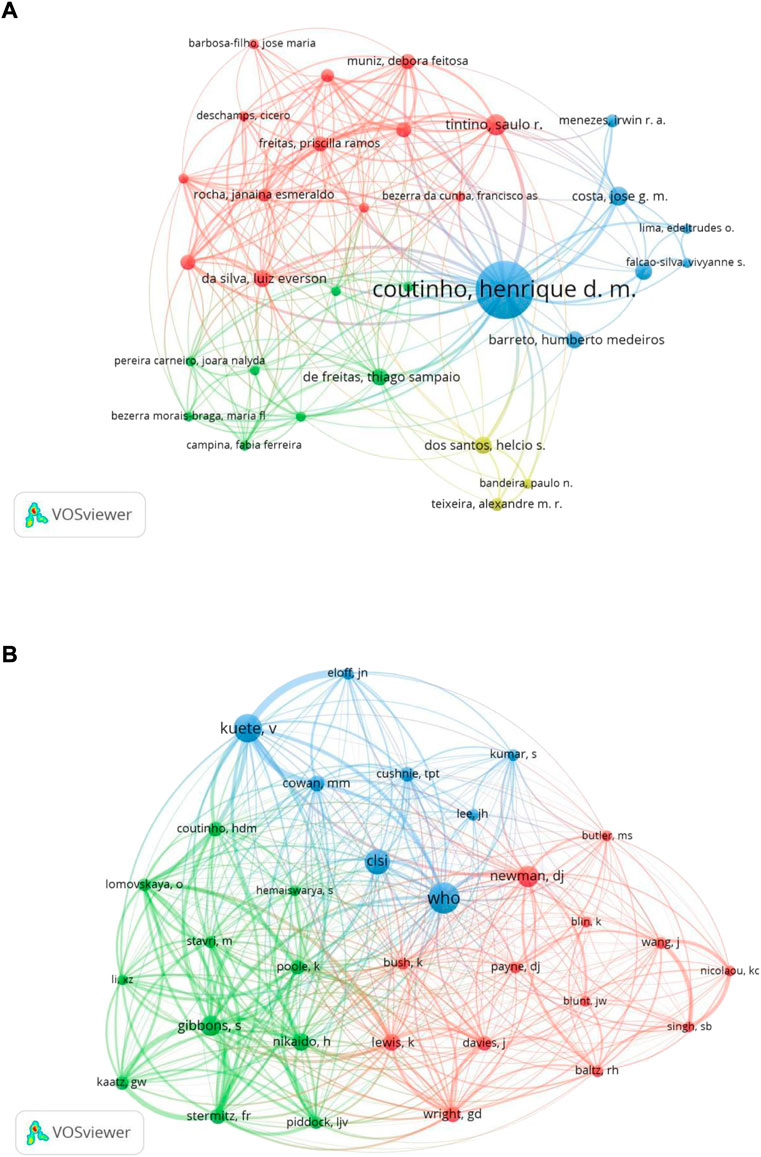
FIGURE 5. Network visualization map of authors (A) and co-cited authors (B) related to resistance of natural products to MDR bacteria.
Journal analysis
In total, 505 journals emerged in this field. The 10 journals with the most publications are listed in Table 3. The top 10 active journals published a total of 228 articles, accounting for 18% of all 1,267 articles. Frontiers in Microbiology published the most articles (36, 2.84%), followed by Molecules (34, 2.68%), BMC Complementary and Alternative Medicine (29, 2.29%), Antibiotics-Basel (27, 2.13%), and Marine Drugs (19, 1.50%). Among the top 10 prolific journals, Marine Drugs had the highest IF of 6.085, followed by Frontiers in Microbiology (6.064) and Applied Microbiology and Biotechnology (5.560). Applied Microbiology and Biotechnology had the highest citation/publication ratio (40.07). According to the 2021 edition of the JCR, five, four, and one journals were classified in Q1, Q2 and Q3, respectively.

TABLE 3. The top 10 journals and co-cited journals related to resistance of natural products to MDR bacteria.
In addition, Table 3 presents the top 10 co-cited journals that published related articles. Antimicrobial Agents and Chemotherapy had the largest number of co-citations (2,774 times), followed by Journal of Natural Products (1,360 times), Journal of Antimicrobial Chemotherapy (1,093 times), Journal of Bacteriology (1,090 times), Journal of Ethnopharmacology (1,090 times), and Proceedings of the National Academy of Sciences of the United States of America (1,090 times). The co-citation relationship among journals was visualized in Figure 6. Of the 10,006 co-cited journals, only journals with a minimum number of 400 citations were included, and 35 journals met the threshold. The top five journals with the greatest TLS were Antimicrobial Agents and Chemotherapy (TLS = 237,116), Journal of Natural Products (TLS = 108,403), Proceedings of the National Academy of Sciences of the United States of America (TLS = 102,850), Journal of Antimicrobial Chemotherapy (TLS = 95,281), and Journal of Bacteriology (TLS = 92,460).
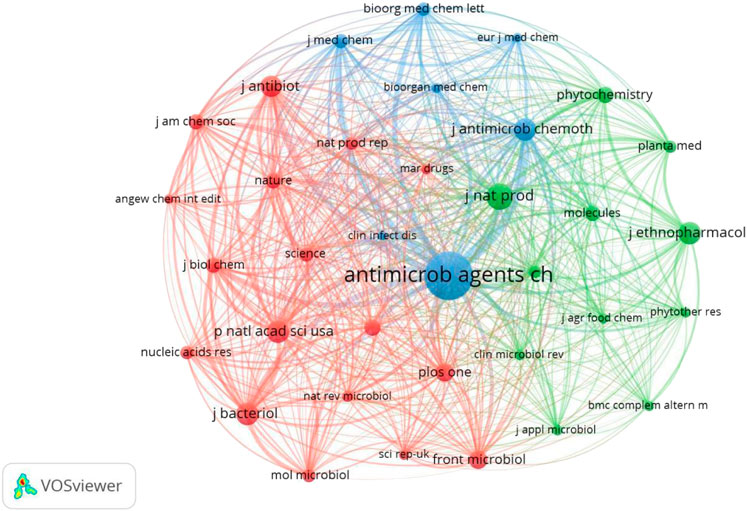
FIGURE 6. Network visualization map of co-cited journals related to resistance of natural products to MDR bacteria.
Reference analysis
According to the document citation analysis, a total of 75 papers were cited more than 100 times (Figure 7A). The basic information of the top 10 most-cited papers is lists in Table 4. These studies were published between 1997 and 2017, six of which were published before 2010. In terms of publication type, 7 were original articles and 3 were reviews. The most cited paper, “Antibiotics for emerging pathogens”, was written by Fischbach and Walsh (2009), with 1,227 citations. The second most cited paper, “Polyphenols as antimicrobial agents”, was written by Daglia (2012), with 779 citations. The third-ranked paper, “Antimicrobial and phytochemical studies on 45 Indian medicinal plants against multi-drug resistant human pathogens”, was written by Ahmad and Beg (2001), with 556 citations. In total, there were 62,965 co-cited references. We presented 54 of these references that were co-cited more than 20 times (Figure 7B). The three references with the largest number of co-citations were written by Cowan (1999) (Clinical microbiology reviews; 86 times), Stavri et al. (2007) (The Journal of antimicrobial chemotherapy; 55 times), and Davies and Davies (2010) (Microbiology and molecular biology reviews; 47 times).
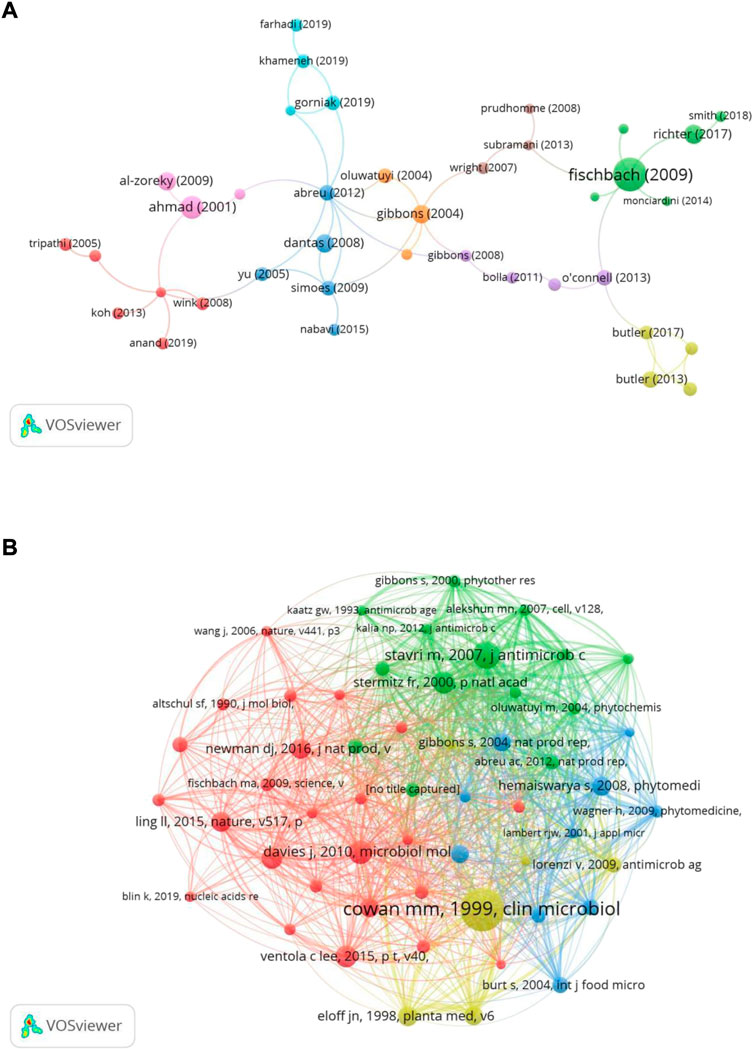
FIGURE 7. Network visualization map of documents (A) and co-cited references (B) related to resistance of natural products to MDR bacteria.
Analysis of Co-cccurrence keywords
Keywords are the concentration and refinement of the content of a paper, and keyword co-occurrence analysis is a commonly used scientometric method to track scientific development and identify research hotspots and emerging trends (Deng et al., 2020). There are 2,944 author keywords in 1,267 articles. The singular and plural forms, full and abbreviated forms, and synonyms of keywords were unified, and the keywords with general meaning were filtered out. Meanwhile, some keywords with high frequency but no analytical meaning were excluded, such as natural products, MDR, antibacterial activity and other search words. Only keywords with at least 6 co-occurrences were visualized, and 70 keywords reached this threshold in a density map (Figure 8). Among them, the top 20 keywords with frequency of occurrence are shown in Table 5. The most frequently occurring keywords were “medicinal plants”, “methicillin-resistant Staphylococcus aureus”, “Staphylococcus aureus”, “biofilm”, “minimum inhibitory concentration (MIC)”, “efflux pumps”, and so on.
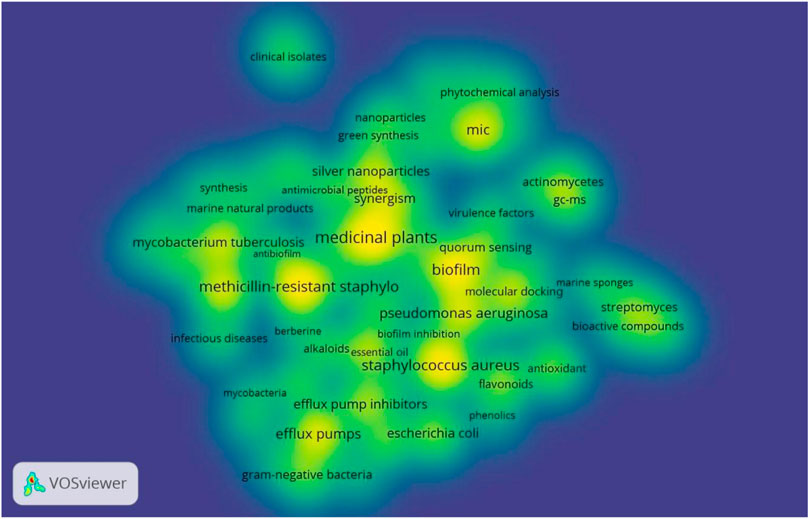
FIGURE 8. Density visualization map of keywords related to resistance of natural products to MDR bacteria.
As shown in Figure 9A, all these selected keywords were grouped into 8 clusters according to the co-occurrence relation network. After further sorting, these 8 clusters could be roughly divided into four main themes: “MDR bacteria” (red and light blue nodes), “mechanism of MDR” (dark blue nodes), “natural product sources and components” (brown and orange nodes), and “natural product development approach” (yellow, green, and purple nodes). In the theme of “MDR bacteria”, the frequently used keywords were “methicillin-resistant Staphylococcus aureus”, “Staphylococcus aureus”, “tuberculosis”, “Pseudomonas aeruginosa”, “Mycobacterium tuberculosis”, and “Escherichia coli”. In “mechanism for inhibiting MDR” theme, the prominent keywords were “efflux pumps” and “efflux pump inhibitors”. As for “natural product sources and components” theme, the primary keywords were “medicinal plants”, “flavonoids”, “antioxidant”, “alkaloids”, and “phenolics”. In the last theme, the major keywords were “MIC”, “molecular docking”, “silver nanoparticles”, and “synergism”.
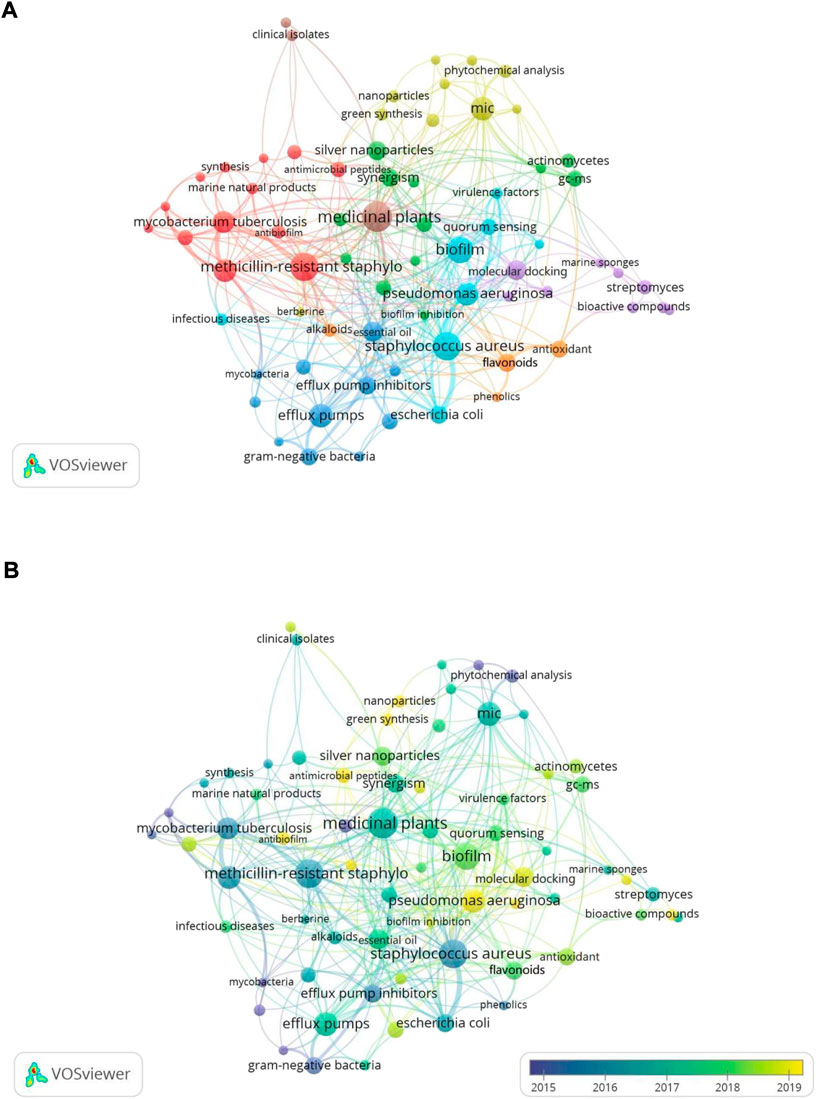
FIGURE 9. Network (A) and overlay (B) visualization map of keywords related to resistance of natural products to MDR bacteria.
In the overlay visualization map, the nodes for each keyword were colored based on their average publication year (Figure 9B). According to the color scale in the lower right corner, nodes identified in purple represented keywords that appeared before or around 2015, while keywords appearing around 2017 were identified in green, and keywords appearing around 2019 or after were coded in yellow. For example, “phytochemical analysis” and “gram-negative bacteria” appeared more frequently in the early stage. Keywords such as “Pseudomonas aeruginosa”, “nanoparticles”, “green synthesis”, “antimicrobial peptides”, “antibiofilm”, “antibiofilm activity”, “biosynthetic gene clusters”, and “molecular dynamics simulation” (the labels of the last three nodes are not shown in the map due to their location) were found in relatively recent years, implying that these topics have become popular and may become research hotspots of this field in coming years. Meanwhile, keywords in “natural product development approach” related clusters had the latest average publication year compared with other themes, indicating that research in this direction has received considerable attention recently.
Discussion
According to the data of the WOS Core Collection database from 1997 to 2021, a total of 1,267 publications in 5 languages were retrieved, and the cumulative number of citations was 34,719. With the prevalence of bacterial resistance issues, studies on the antimicrobial activity of natural products against MDR bacteria has generated considerable exploratory interest, whether in terms of annual published documents or citation counts. Among the 95 countries/Regions involved in the publication of studies in this field, India was the most productive country. The United States ranked second in the total number of publications; however, it was the leading country in the total number of citations. Furthermore, the United States was the most active country in international cooperation and had close collaborations with India, China, Germany and Canada. In addition, China, India, Saudi Arabia, and Germany demonstrated active international cooperation as well. Therefore, combined with the quality and quantity of publications and international cooperation, the United States and India were dominant in this research field. In terms of institutional contribution, the University of Dschang had the largest output. As for the institution co-authorship analysis, the Regional University of Cariri, Federal University of Paraiba, Universidade Federal do Piaui, University of Dschang, and University of Porto showed active cooperation.
To some extent, the number of scientific papers published by an author in a certain field represents his contribution and activity in that field (Wu, et al., 2021b). Most researchers published only one or two papers, meaning that only a handful of authors made sustained contributions to the field. Three authors published more than 10 articles, namely Coutinho HDM, Kuete V and Gibbons S, with 33, 31 and 12 papers respectively. As for author co-authorship analysis, from the perspective of centrality, Coutinho HDM was located at a central position of the cooperating clusters. In author co-citation analysis, combined with the values of co-citations and TLS, Kuete V, Gibbons S and WHO were prominent in this field. Overall, the above results indicated that Coutinho HDM, Kuete V, and Gibbons S made significant contributions in this field. Based on the journal analysis, all papers included in this study were published in 505 journals. Among them, Frontiers in Microbiology (6.064, Q1), Molecules (4.927, Q2), BMC Complementary and Alternative Medicine (2.838, Q2), Antibiotics-Basel (5.222, Q1), and Marine Drugs (6.085, Q1) published the most paper in this research field. In addition to the number of publications, citation frequency is often considered as an important indicator to evaluate the influence of a journal (Wu, et al., 2021b). In the journal co-citation network graph, Antimicrobial Agents and Chemotherapy had the highest co-citations, followed by Journal of Natural Products, Journal of Antimicrobial Chemotherapy, Journal of Bacteriology, Journal of Ethnopharmacology, and Proceedings of the National Academy of Sciences of the United States of America. In general, there is a high probability that future achievements in the field will be published in the listed journals.
The top 10 highly cited papers were published between 1997 and 2017, with six published before 2010. In terms of research content, most of the top 10 most cited papers focused on the discovery of new antibiotics, especially natural product antibiotics of plants and natural products of plants were the primary source. The paper with the highest cited times, written by Fischbach and Walsh (2009) was published in Science, with 1,227 citations. It noted out that methods of new scaffold discovery, such as mining under-explored microbial niche for natural products, were promising approaches against MDR pathogens. The second most cited article was published in Current Opinion in Biotechnology by Daglia (2012). It discussed the synergistic effect of polyphenols in combination with conventional antibiotics against clinical MDR microorganisms. The research topics of five other papers also focused on the antibacterial activity of natural products of plant origin (Ahmad and Beg, 2001; Gibbons, 2004; Al-Zoreky, 2009; Ghosh, et al., 2012; Gopinath, et al., 2012), including two papers on synthesis of silver nanoparticles. The most recent article published in Nature with 402 citations. Richter et al. (2017) predicted compound accumulation rules in bacteria to aid in the discovery and development of novel antibacterial agents against Gram-negative bacteria. Co-cited references are documents in which two publications are cited together by other publications so that they can be considered as the background and foundation of research in a particular field (Ke, et al., 2020). Overall, the top 10 co-citations were focused on the following subjects: antibacterial activity of plant-derived natural products (Cowan, 1999; Kuete, 2010; Stermitz, et al., 2000); antibiotic discovery (efflux pump or cell wall inhibitors) (Ling, et al., 2015; Newman and Cragg, 2016; Stavri et al., 2007); antibiotic resistance (Davies and Davies, 2010); antibacterial discovery process, achievements, and challenges (Payne, et al., 2007); and MIC determination method (Eloff, 1998).
Keyword co-occurrence analysis is commonly used to highlight the frequently occurring keywords that can reveal the subject content and provide a reasonable description of the knowledge structure (Wu et al., 2021b). Meanwhile, the current hot topics and future directions can also be revealed (Guo et al., 2021). The analysis demonstrated that “medicinal plants”, “methicillin-resistant Staphylococcus aureus”, “Staphylococcus aureus”, “biofilm”, “MIC”, and “efflux pumps” were the most commonly used keywords in order, so these terms are presumed to be the hot spots in this field. Combining the formed clusters and all co-occurring keywords, among the related clusters of “MDR bacteria”, methicillin-resistant Staphylococcus aureus, Pseudomonas aeruginosa (Tasneem et al., 2022), Mycobacterium tuberculosis (Li et al., 2022), and Escherichia coli (Szmolka and Nagy, 2013) were the most frequently mentioned strains. In addition, Acinetobacter baumannii (Borges Duarte and Gonçalves Rodrigues, 2022) and Klebsiella pneumoniae (Ali et al., 2022) could be found in the co-occurring keywords. In “mechanism for inhibiting MDR” theme, suppression of the efflux pump was the primary mechanism studied (Nikaido, 2009). Moreover, anti-biofilm action was also a focus mechanism (Hathroubi, et al., 2017; Mishra, et al., 2020). As for “natural product sources and components” theme, medicinal plant-derived compounds gained significant attention as potential sources of new antimicrobial agents to combat MDR bacteria (Subramani et al., 2017). Besides, actinomycetes and marine natural products were also vital sources (Hou, et al., 2019; Jagannathan, et al., 2021; Zhu, et al., 2014). The notable active components were flavonoids (Song, et al., 2022), alkaloids and phenolics (Suganya, et al., 2022). Essential oil (Badescu, et al., 2022), polyphenols (Jubair, et al., 2021), and berberine (Yu, et al., 2005) were also included in the co-occurrence keywords. In “natural product development approach” theme, biosynthesis of nanoparticles, especially silver nanoparticles, had attracted much attention in order to develop new antibiotics (Anjum and Abbasi, 2016; Alavi, et al., 2022a; Alavi, et al., 2022b; Majoumouo, et al., 2019). Additionally, molecular docking was an impactful technology in drug design in this field (Miryala, et al., 2021). From the overlay visualization map, recent studies mainly focused on the theme of “natural product development approach”. Furthermore, the results showed that keywords such as “Pseudomonas aeruginosa”, “nanoparticles”, “green synthesis”, “antimicrobial peptides”, “antibiofilm”, “antibiofilm activity”, “biosynthetic gene clusters”, and “molecular dynamics simulation” had the latest average appearance year, indicating that these topics may become the research direction in the next few years.
In addition, the main limitations of our analysis are as follows: First, we only searched in the WOS database, and not in other databases such as PubMed, Embase, or Scopus. Therefore, the comprehensiveness of the data will be deficient to some extent. Second, we did not include relevant papers in 2022 because the data of this year are not yet complete enough to complete certain annual data comparison. As a result, some of the latest research progress may be missed. Third, all data in this study were extracted by software, unlike systematic reviews that are manually extracted by two or more independent authors. In consequence, the data used to derive the results in this paper may be biased.
Conclusion
With the prevalence of bacterial resistance problems, interest in the antimicrobial activity of natural products against MDR bacteria has exploded during the past decades. In this study, the current research status and emerging global trends in this field were visualized using a scientometric method. A total of 1,267 related documents including 1,005 original articles and 262 reviews in a period from 1997 to 2021 were retrieved. India is the country with the most output, and the United States is the country with the highest total citations and the most active in international cooperation. The University of Dschang from Cameroon produced the most publications. Coutinho HDM, Kuete V, and Gibbons S had significant influence in this field, as they published a large number of articles and were co-cited in several more publications. Frontiers in Microbiology and Antimicrobial Agents and Chemotherapy were major journals with the highest number of publications and co-citations, respectively. Fischbach and Walsh published the most cited paper in Science with 1,227 citations. The content of most of the top 10 most cited papers focused on the discovery of new antibiotics, especially plant-derived natural product antibiotics. Based on keywords co-occurrence analysis, “medicinal plants”, “methicillin-resistant Staphylococcus aureus”, “Staphylococcus aureus”, “biofilm”, “MIC”, and “efflux pumps” were the most frequently used keywords, so these terms are presumed to be the current hot topics. All selected keywords could be roughly divided into four main themes: “MDR bacteria”, “mechanism for inhibiting MDR”, “natural product sources and components”, and “natural product development approach”, of which the last theme had attracted much attention in recent years. Methicillin-resistant Staphylococcus aureus, Pseudomonas aeruginosa, Mycobacterium tuberculosis, and Escherichia coli were the most commonly studied MDR strains, followed by Acinetobacter baumannii and Klebsiella pneumoniae. Inhibition of the efflux pump and anti-biofilm action were the primary mechanism for suppressing MDR. Medicinal plant-derived compounds such as flavonoids, alkaloids, and phenolics were important sources of novel antimicrobial agents against MDR bacteria, followed by actinomycetes and marine natural products. Besides, biosynthesis of nanoparticles, especially silver nanoparticles, was a new strategy to develop highly effective antibacterial agents. Molecular docking was also an important method in this field. Moreover, keywords such as “Pseudomonas aeruginosa”, “nanoparticles”, “green synthesis”, “antimicrobial peptides”, “antibiofilm”, “antibiofilm activity”, “biosynthetic gene clusters”, and “molecular dynamics simulation” had the latest average appearance year, indicating that these topics may become the research hot spots in the coming years. Overall, this study performed a scientometric analysis of the antibacterial activity of natural products against MDR bacteria from a holistic perspective. We hope it can provide an effective reference for the research points and future trends, not only for researchers already working in this field, but also for new researchers interested in this field.
Data availability statement
The original contributions presented in the study are included in the article/supplementary material, further inquiries can be directed to the corresponding author.
Author contributions
Y-XZ performed search, collected data, conducted analysis, and drafted the manuscript. X-YC re-checked data and supervised process. CP designed the study and revised the final version.
Funding
This work was supported by Xinglin Scholar Fund of Chengdu University of Traditional Chinese Medicine (YXRC2018006).
Conflict of interest
The authors declare that the research was conducted in the absence of any commercial or financial relationships that could be construed as a potential conflict of interest.
Publisher’s note
All claims expressed in this article are solely those of the authors and do not necessarily represent those of their affiliated organizations, or those of the publisher, the editors and the reviewers. Any product that may be evaluated in this article, or claim that may be made by its manufacturer, is not guaranteed or endorsed by the publisher.
References
Ahmad, I., and Beg, A. Z. (2001). Antimicrobial and phytochemical studies on 45 Indian medicinal plants against multi-drug resistant human pathogens. J. Ethnopharmacol. 74 (2), 113–123. doi:10.1016/s0378-8741(00)00335-4
Al-Zoreky, N. S. (2009). Antimicrobial activity of pomegranate (Punica granatum L.) fruit peels. Int. J. Food Microbiol. 134 (3), 244–248. doi:10.1016/j.ijfoodmicro.2009.07.002
Alavi, M., Kowalski, R., Capasso, R., Douglas Melo Coutinho, H., and Rose Alencar de Menezes, I. (2022a). Various novel strategies for functionalization of gold and silver nanoparticles to hinder drug-resistant bacteria and cancer cells. Micro Nano Bio Asp. 1 (1), 38–48. Available at: https://www.mnba-journal.com/article_152629.html.
Alavi, M., Thomas, S., and Sreedharan, M. (2022b). Modification of silica nanoparticles for antibacterial activities: Mechanism of action. Micro Nano Bio Asp. 1 (1), 49–58. Available at: https://www.mnba-journal.com/article_153448.html.
Ali, S., Alam, M., Hasan, G. M., and Hassan, M. I. (2022). Potential therapeutic targets of Klebsiella pneumoniae: A multi-omics review perspective. Brief. Funct. Genomics 21 (2), 63–77. doi:10.1093/bfgp/elab038
Anjum, S., and Abbasi, B. H. (2016). Biomimetic synthesis of antimicrobial silver nanoparticles using in vitro-propagated plantlets of a medicinally important endangered species: Phlomis bracteosa. Int. J. Nanomedicine 11, 1663–1675. doi:10.2147/IJN.S105532
Aslam, B., Wang, W., Arshad, M. I., Khurshid, M., Muzammil, S., Rasool, M. H., et al. (2018). Antibiotic resistance: A rundown of a global crisis. Infect. Drug Resist. 11, 1645–1658. doi:10.2147/IDR.S173867
Badescu, B., Buda, V., Romanescu, M., Lombrea, A., Danciu, C., Dalleur, O., et al. (2022). Current state of knowledge regarding WHO critical priority pathogens: Mechanisms of resistance and proposed solutions through candidates such as essential oils. Plants Basel, Switz. 11 (14), 1789. doi:10.3390/plants11141789
Borges Duarte, D. F., and Gonçalves Rodrigues, A. (2022). Acinetobacter baumannii: Insights towards a comprehensive approach for the prevention of outbreaks in health-care facilities. APMIS acta pathologica, Microbiol. Immunol. Scand. 130 (6), 330–337. doi:10.1111/apm.13227
Bornmann, L., and Leydesdorff, L. (2014). Scientometrics in a changing research landscape: Bibliometrics has become an integral part of research quality evaluation and has been changing the practice of research. EMBO Rep. 15 (12), 1228–1232. doi:10.15252/embr.201439608
Chen, L., Yang, Y., Fan, J., Zhang, Y., and Li, N. (2021). Trends of high-impact studies in Pharmacology and pharmacy: A cross-sectional study. Front. Pharmacol. 12, 726668. doi:10.3389/fphar.2021.726668
Cowan, M. M. (1999). Plant products as antimicrobial agents. Clin. Microbiol. Rev. 12 (4), 564–582. doi:10.1128/CMR.12.4.564
Daglia, M. (2012). Polyphenols as antimicrobial agents. Curr. Opin. Biotechnol. 23 (2), 174–181. doi:10.1016/j.copbio.2011.08.007
Davies, J., and Davies, D. (2010). Origins and evolution of antibiotic resistance. Microbiol. Mol. Biol. Rev. 74 (3), 417–433. doi:10.1128/MMBR.00016-10
de Castilhos Ghisi, N., Zuanazzi, N. R., Fabrin, T., and Oliveira, E. C. (2020). Glyphosate and its toxicology: A scientometric review. Sci. Total Environ. 733, 139359. doi:10.1016/j.scitotenv.2020.139359
Deng, Z., Wang, H., Chen, Z., and Wang, T. (2020). Bibliometric analysis of dendritic epidermal T cell (DETC) research from 1983 to 2019. Front. Immunol. 11, 259. doi:10.3389/fimmu.2020.00259
Eloff, J. N. (1998). A sensitive and quick microplate method to determine the minimal inhibitory concentration of plant extracts for bacteria. Planta Med. 64 (8), 711–713. doi:10.1055/s-2006-957563
Fischbach, M. A., and Walsh, C. T. (2009). Antibiotics for emerging pathogens. Sci. (New York, N.Y.) 325 (5944), 1089–1093. doi:10.1126/science.1176667
Ghosh, S., Patil, S., Ahire, M., Kitture, R., Kale, S., Pardesi, K., et al. (2012). Synthesis of silver nanoparticles using Dioscorea bulbifera tuber extract and evaluation of its synergistic potential in combination with antimicrobial agents. Int. J. Nanomedicine 7, 483–496. doi:10.2147/IJN.S24793
Gibbons, S. (2004). Anti-staphylococcal plant natural products. Nat. Prod. Rep. 21 (2), 263–277. doi:10.1039/b212695h
Gopinath, V., MubarakAli, D., Priyadarshini, S., Priyadharsshini, N. M., Thajuddin, N., and Velusamy, P. (2012). Biosynthesis of silver nanoparticles from tribulus terrestris and its antimicrobial activity: A novel biological approach. Colloids Surf. B Biointerfaces 96, 69–74. doi:10.1016/j.colsurfb.2012.03.023
Guo, J., Gu, D., Zhao, T., Zhao, Z., Xiong, Y., Sun, M., et al. (2021). Trends in piezo channel research over the past decade: A bibliometric analysis. Front. Pharmacol. 12, 668714. doi:10.3389/fphar.2021.668714
Hashem, A. H., and Salem, S. S. (2022). Green and ecofriendly biosynthesis of selenium nanoparticles using Urtica dioica (stinging nettle) leaf extract: Antimicrobial and anticancer activity. Biotechnol. J. 17 (2), e2100432. doi:10.1002/biot.202100432
Hashem, A. H., Shehabeldine, A. M., Ali, O. M., and Salem, S. S. (2022). Synthesis of chitosan-based gold nanoparticles: Antimicrobial and wound-healing activities. Polymers 14 (11), 2293. doi:10.3390/polym14112293
Hathroubi, S., Mekni, M. A., Domenico, P., Nguyen, D., and Jacques, M. (2017). Biofilms: Microbial shelters against antibiotics. Microb. Drug Resist. 23 (2), 147–156. doi:10.1089/mdr.2016.0087
Hou, X. M., Wang, C. Y., Gerwick, W. H., and Shao, C. L. (2019). Marine natural products as potential anti-tubercular agents. Eur. J. Med. Chem. 165, 273–292. doi:10.1016/j.ejmech.2019.01.026
Huang, Z., Hou, Z., Liu, F., Zhang, M., Hu, W., and Xu, S. (2021). Scientometric analysis of medicinal and edible plant coptis. Front. Pharmacol. 12, 725162. doi:10.3389/fphar.2021.725162
Jagannathan, S. V., Manemann, E. M., Rowe, S. E., Callender, M. C., and Soto, W. (2021). Marine actinomycetes, new sources of biotechnological products. Mar. Drugs 19 (7), 365. doi:10.3390/md19070365
Jubair, N., Rajagopal, M., Chinnappan, S., Abdullah, N. B., and Fatima, A. (2021). Review on the antibacterial mechanism of plant-derived compounds against multidrug-resistant bacteria (MDR). Evid. Based. Complement. Altern. Med. 2021, 3663315. doi:10.1155/2021/3663315
Ke, L., Lu, C., Shen, R., Lu, T., Ma, B., and Hua, Y. (2020). Knowledge mapping of drug-induced liver injury: A scientometric investigation (2010-2019). Front. Pharmacol. 11, 842. doi:10.3389/fphar.2020.00842
Kuete, V. (2010). Potential of Cameroonian plants and derived products against microbial infections: A review. Planta Med. 76 (14), 1479–1491. doi:10.1055/s-0030-1250027
Laxminarayan, R., Duse, A., Wattal, C., Zaidi, A. K., Wertheim, H. F., Sumpradit, N., et al. (2013). Antibiotic resistance-the need for global solutions. Lancet. Infect. Dis. 13 (12), 1057–1098. doi:10.1016/S1473-3099(13)70318-9
Li, H., Yuan, J., Duan, S., and Pang, Y. (2022). Resistance and tolerance of Mycobacterium tuberculosis to antimicrobial agents-How M. tuberculosis can escape antibiotics. WIREs Mech. Dis. 14 (3), e1573. doi:10.1002/wsbm.1573
Ling, L. L., Schneider, T., Peoples, A. J., Spoering, A. L., Engels, I., Conlon, B. P., et al. (2015). A new antibiotic kills pathogens without detectable resistance. Nature 517 (7535), 455–459. doi:10.1038/nature14098
Majoumouo, M. S., Sibuyi, N., Tincho, M. B., Mbekou, M., Boyom, F. F., and Meyer, M. (2019). Enhanced anti-bacterial activity of biogenic silver nanoparticles synthesized from Terminalia mantaly extracts. Int. J. Nanomedicine 14, 9031–9046. doi:10.2147/IJN.S223447
Michael, C. A., Dominey-Howes, D., and Labbate, M. (2014). The antimicrobial resistance crisis: Causes, consequences, and management. Front. public health 2, 145. doi:10.3389/fpubh.2014.00145
Miryala, S. K., Basu, S., Naha, A., Debroy, R., Ramaiah, S., Anbarasu, A., et al. (2021). Identification of bioactive natural compounds as efficient inhibitors against Mycobacterium tuberculosis protein-targets: A molecular docking and molecular dynamics simulation study. J. Mol. Liq. 341, 117340. doi:10.1016/j.molliq.2021.117340
Mishra, R., Panda, A. K., De Mandal, S., Shakeel, M., Bisht, S. S., and Khan, J. (2020). Natural anti-biofilm agents: Strategies to Control biofilm-forming pathogens. Front. Microbiol. 11, 566325. doi:10.3389/fmicb.2020.566325
Moloney, M. G. (2016). Natural products as a source for novel antibiotics. Trends Pharmacol. Sci. 37 (8), 689–701. doi:10.1016/j.tips.2016.05.001
Moore, B. S., Carter, G. T., and Brönstrup, M. (2017). Editorial: Are natural products the solution to antimicrobial resistance? Nat. Prod. Rep. 34 (7), 685–686. doi:10.1039/c7np90026k
Nathan, C., and Cars, O. (2014). Antibiotic resistance--problems, progress, and prospects. N. Engl. J. Med. 371 (19), 1761–1763. doi:10.1056/NEJMp1408040
Newman, D. J., and Cragg, G. M. (2016). Natural products as sources of new drugs from 1981 to 2014. J. Nat. Prod. 79 (3), 629–661. doi:10.1021/acs.jnatprod.5b01055
Nikaido, H. (2009). Multidrug resistance in bacteria. Annu. Rev. Biochem. 78, 119–146. doi:10.1146/annurev.biochem.78.082907.145923
O'Connell, K. M., Hodgkinson, J. T., Sore, H. F., Welch, M., Salmond, G. P., and Spring, D. R. (2013). Combating multidrug-resistant bacteria: Current strategies for the discovery of novel antibacterials. Angew. Chem. Int. Ed. Engl. 52 (41), 10706–10733. doi:10.1002/anie.201209979
Payne, D. J., Gwynn, M. N., Holmes, D. J., and Pompliano, D. L. (2007). Drugs for bad bugs: Confronting the challenges of antibacterial discovery. Nat. Rev. Drug Discov. 6 (1), 29–40. doi:10.1038/nrd2201
Richter, M. F., Drown, B. S., Riley, A. P., Garcia, A., Shirai, T., Svec, R. L., et al. (2017). Predictive compound accumulation rules yield a broad-spectrum antibiotic. Nature 545 (7654), 299–304. doi:10.1038/nature22308
Rogers Van Katwyk, S., Hoffman, S. J., Mendelson, M., Taljaard, M., and Grimshaw, J. M. (2020). Strengthening the science of addressing antimicrobial resistance: A framework for planning, conducting and disseminating antimicrobial resistance intervention research. Health Res. Policy Syst. 18 (1), 60. doi:10.1186/s12961-020-00549-1
Rossiter, S. E., Fletcher, M. H., and Wuest, W. M. (2017). Natural products as platforms to overcome antibiotic resistance. Chem. Rev. 117 (19), 12415–12474. doi:10.1021/acs.chemrev.7b00283
Salem, S. S., Badawy, M., Al-Askar, A. A., Arishi, A. A., Elkady, F. M., and Hashem, A. H. (2022). Green biosynthesis of selenium nanoparticles using orange peel waste: Characterization, antibacterial and antibiofilm activities against multidrug-resistant bacteria. Life (Basel, Switz. 12 (6), 893. doi:10.3390/life12060893
Song, L., Hu, X., Ren, X., Liu, J., and Liu, X. (2022). Antibacterial modes of herbal flavonoids combat resistant bacteria. Front. Pharmacol. 13, 873374. doi:10.3389/fphar.2022.873374
Spellberg, B., Srinivasan, A., and Chambers, H. F. (2016). New societal approaches to empowering antibiotic stewardship. JAMA 315 (12), 1229–1230. doi:10.1001/jama.2016.1346
Stavri, M., Piddock, L. J., and Gibbons, S. (2007). Bacterial efflux pump inhibitors from natural sources. J. Antimicrob. Chemother. 59 (6), 1247–1260. doi:10.1093/jac/dkl460
Stermitz, F. R., Lorenz, P., Tawara, J. N., Zenewicz, L. A., and Lewis, K. (2000). Synergy in a medicinal plant: Antimicrobial action of berberine potentiated by 5'-methoxyhydnocarpin, a multidrug pump inhibitor. Proc. Natl. Acad. Sci. U. S. A. 97 (4), 1433–1437. doi:10.1073/pnas.030540597
Subramani, R., Narayanasamy, M., and Feussner, K. D. (2017). Plant-derived antimicrobials to fight against multi-drug-resistant human pathogens. 3 Biotech. 7 (3), 172. doi:10.1007/s13205-017-0848-9
Suganya, T., Packiavathy, I., Aseervatham, G., Carmona, A., Rashmi, V., Mariappan, S., et al. (2022). Tackling multiple-drug-resistant bacteria with conventional and complex phytochemicals. Front. Cell. Infect. Microbiol. 12, 883839. doi:10.3389/fcimb.2022.883839
Szmolka, A., and Nagy, B. (2013). Multidrug resistant commensal Escherichia coli in animals and its impact for public health. Front. Microbiol. 4, 258. doi:10.3389/fmicb.2013.00258
Tasneem, U., Mehmood, K., Majid, M., Ullah, S. R., and Andleeb, S. (2022). Methicillin resistant Staphylococcus aureus: A brief review of virulence and resistance. J. Pak. Med. Assoc. 72 (3), 509–515. doi:10.47391/JPMA.0504
Willem, L., Verelst, F., Bilcke, J., Hens, N., and Beutels, P. (2017). Lessons from a decade of individual-based models for infectious disease transmission: A systematic review (2006-2015). BMC Infect. Dis. 17 (1), 612. doi:10.1186/s12879-017-2699-8
Wright, G. D. (2017). Opportunities for natural products in 21st century antibiotic discovery. Nat. Prod. Rep. 34 (7), 694–701. doi:10.1039/c7np00019g
Wu, H., Tong, L., Wang, Y., Yan, H., and Sun, Z. (2021a). Bibliometric analysis of global research trends on ultrasound microbubble: A quickly developing field. Front. Pharmacol. 12, 646626. doi:10.3389/fphar.2021.646626
Wu, H., Zhou, Y., Wang, Y., Tong, L., Wang, F., Song, S., et al. (2021b). Current state and future directions of intranasal delivery route for central nervous system disorders: A scientometric and visualization analysis. Front. Pharmacol. 12, 717192. doi:10.3389/fphar.2021.717192
Yu, H. H., Kim, K. J., Cha, J. D., Kim, H. K., Lee, Y. E., Choi, N. Y., et al. (2005). Antimicrobial activity of berberine alone and in combination with ampicillin or oxacillin against methicillin-resistant Staphylococcus aureus. J. Med. Food 8 (4), 454–461. doi:10.1089/jmf.2005.8.454
Zaman, S. B., Hussain, M. A., Nye, R., Mehta, V., Mamun, K. T., and Hossain, N. (2017). A review on antibiotic resistance: Alarm bells are ringing. Cureus 9 (6), e1403. doi:10.7759/cureus.1403
Keywords: antibacterial activity, MDR, natural products, biofilm, scientometric analysis
Citation: Zhou Y-X, Cao X-Y and Peng C (2022) Antimicrobial activity of natural products against MDR bacteria: A scientometric visualization analysis. Front. Pharmacol. 13:1000974. doi: 10.3389/fphar.2022.1000974
Received: 22 July 2022; Accepted: 13 September 2022;
Published: 26 September 2022.
Edited by:
Salem S. Salem, Al-Azhar University, EgyptReviewed by:
Amr H. Hashem, Al-Azhar University, EgyptMohammed Abu-Elghait, Al-Azhar University, Egypt
Mehran Alavi, Razi University, Iran
Copyright © 2022 Zhou, Cao and Peng. This is an open-access article distributed under the terms of the Creative Commons Attribution License (CC BY). The use, distribution or reproduction in other forums is permitted, provided the original author(s) and the copyright owner(s) are credited and that the original publication in this journal is cited, in accordance with accepted academic practice. No use, distribution or reproduction is permitted which does not comply with these terms.
*Correspondence: Cheng Peng, cGVuZ2NjaGVuZ2RAMTYzLmNvbQ==
 Yan-Xi Zhou
Yan-Xi Zhou Xiao-Yu Cao1
Xiao-Yu Cao1 Cheng Peng
Cheng Peng